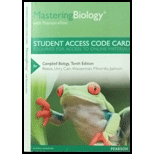
Concept explainers
To describe: Three specializations of the plant organs and plant cells that help them to adapt their life on the land.
Introduction: Vascular plants, also called tracheophytes, form a large group of plants that use specialized tissues for transporting water and food to several parts in the plant.
Explanation of Solution
There are three essential organs of the vascular plants such as the leaves, stems, and roots. Also, there are various plant cells that help in the adaptations of plants on land. For example: the parenchyma cells, sclerenchyma cells, collenchyma cells, the xylem’s water-conducting cells, and phloem’s sugar-conducting cells.
The three specializations of the plants are as follows:
1. Roots: Roots are present in the soil, where it helps in absorbing the water and minerals and stores the carbohydrates. At first, the roots forms primary roots, and then it forms the lateral roots. For acquiring the nutrients and other substances, root hairs are essential, which are beneath the soil.
2. Stems: It is an organ of the plant that comprises the buds and leaves. The most important function of the stem is in elongating and orienting the shoot, so that it would initiate photosynthesis at a maximum rate. The stem consists of internodes, nodes, axillary buds, and the apical buds.
3. Collenchyma cells: These are the cells that are elongated generally and possess thicker primary walls. The walls are thicker than the parenchymatous cells. These cells are essential for supporting the young parts of the shoots of the plants. These cells help in providing support (flexible) without restraining the growth of the plant.
The three essential organs of the vascular plants are leaves, stems, and roots; the three essential plant cells are parenchyma cells, sclerenchyma cells, and collenchyma cells, which help them in adapting their life on the land.
Want to see more full solutions like this?
Chapter 35 Solutions
Mastering Biology with Pearson eText -- Standalone Access Card -- for Campbell Biology (10th Edition)
- When beta-lactamase was isolated from Staphylcoccus aureus and treated with a phosphorylating agent, only the active site, serine was phosphorylated. Additionally, the serine was found to constitute 0.35% (by weight) of this beta-lactamase enzyme. Using this, calculate the molecular weight of this enzyme and estimate the number of amino acids present in the polypeptide.arrow_forwardBased on your results from the Mannitol Salt Agar (MSA) media, which of your bacteria were mannitol fermenters and which were not mannitol fermenters?arrow_forwardhelp tutor pleasearrow_forward
- Q8. A researcher wants to study the effectiveness of a pill intended to reduce stomach heartburn in pregnant women. The researcher chooses randomly 400 women to participate in this experiment for 9 months of their pregnancy period. They all need to have the same diet. The researcher designs two groups of 200 participants: One group take the real medication intended to reduce heartburn, while the other group take placebo medication. In this study what are: Independent variable: Dependent variable: Control variable: Experimental group: " Control group: If the participants do not know who is consuming the real pills and who is consuming the sugar pills. This study is It happens that 40% of the participants do not find the treatment helpful and drop out after 6 months. The researcher throws out the data from subjects that drop out. What type of bias is there in this study? If the company who makes the medication funds this research, what type of bias might exist in this research work?arrow_forwardHow do I determine the inhertiance pattern from the pedigree diagram?arrow_forwardits an open book assignemntarrow_forward
- Describe two different gene regulation mechanisms involving methylationarrow_forwardWhat is behavioral adaptarrow_forward22. Which of the following mutant proteins is expected to have a dominant negative effect when over- expressed in normal cells? a. mutant PI3-kinase that lacks the SH2 domain but retains the kinase function b. mutant Grb2 protein that cannot bind to RTK c. mutant RTK that lacks the extracellular domain d. mutant PDK that has the PH domain but lost the kinase function e. all of the abovearrow_forward
 Biology (MindTap Course List)BiologyISBN:9781337392938Author:Eldra Solomon, Charles Martin, Diana W. Martin, Linda R. BergPublisher:Cengage Learning
Biology (MindTap Course List)BiologyISBN:9781337392938Author:Eldra Solomon, Charles Martin, Diana W. Martin, Linda R. BergPublisher:Cengage Learning Biology: The Dynamic Science (MindTap Course List)BiologyISBN:9781305389892Author:Peter J. Russell, Paul E. Hertz, Beverly McMillanPublisher:Cengage Learning
Biology: The Dynamic Science (MindTap Course List)BiologyISBN:9781305389892Author:Peter J. Russell, Paul E. Hertz, Beverly McMillanPublisher:Cengage Learning Concepts of BiologyBiologyISBN:9781938168116Author:Samantha Fowler, Rebecca Roush, James WisePublisher:OpenStax College
Concepts of BiologyBiologyISBN:9781938168116Author:Samantha Fowler, Rebecca Roush, James WisePublisher:OpenStax College Biology: The Unity and Diversity of Life (MindTap...BiologyISBN:9781337408332Author:Cecie Starr, Ralph Taggart, Christine Evers, Lisa StarrPublisher:Cengage Learning
Biology: The Unity and Diversity of Life (MindTap...BiologyISBN:9781337408332Author:Cecie Starr, Ralph Taggart, Christine Evers, Lisa StarrPublisher:Cengage Learning Biology 2eBiologyISBN:9781947172517Author:Matthew Douglas, Jung Choi, Mary Ann ClarkPublisher:OpenStax
Biology 2eBiologyISBN:9781947172517Author:Matthew Douglas, Jung Choi, Mary Ann ClarkPublisher:OpenStax





